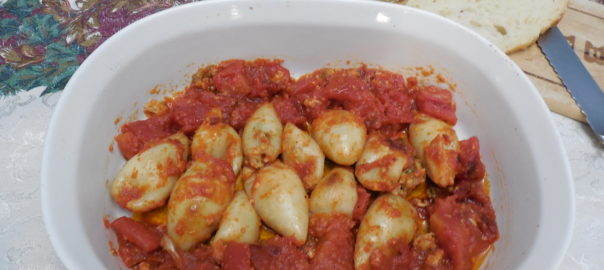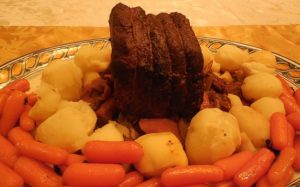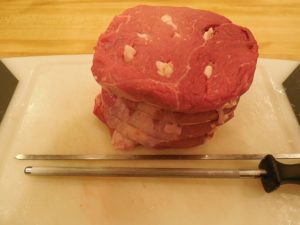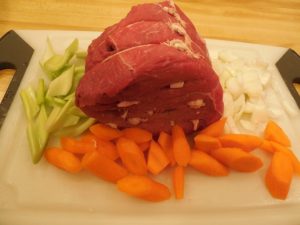Stuffed Calamari, Fried Calamari and Stuffed Sardines for Your Italian Christmas Eve
Try Stuffed Calamari, Fried Calamari or stuffed sardines for your Italian Christmas Eve this year! Recipes courtesy of Sicily and Sardinia.
Italian Christmas Eve means a feast of 7 fishes with Calamari, Stuffed or Fried and Stuffed Sardines
It is an Italian tradition to serve fish for Christmas Eve, in observance of the Catholic holiday. In some towns in Italy and in many Italian-American families, this tradition has turned into a feast that features fish and shellfish for antipasto, primo and secondo courses — fish is served fried, stuffed, with pasta, stewed, and baked. Some families serve seven different types of fish, although I’m not sure if anyone really knows where the number seven originated from.
Each year, I plan my “feast of the 7 fishes” with some tried and true dishes — my shrimp scampi, for instance, is always a big hit for the primo course and easy to make. Last year I had fun with the antipasto course, and cooked up Sicilian and Sardinian-style stuffed calamari and stuffed fresh sardines — which, by the way, do not smell or taste “fishy” at all if you buy them fresh. They were both a hit with young and old alike, so I present them here for your family to try. I’ve also included a simple method for fresh fried calamari, complete with an Instagram video, as a well-known and well-loved family starter to any Italian-American meal.
Buon appetito e Buon Natale!
—Kathryn Occhipinti
Make it an Italian Christmas Eve:
Stuffed Calamari Sardinian Style
Ingredients
(Makes about 12 stuffed calamari (squid)
12 squid with about 3″ sacs
Stuffing:
Tentacles from 6 squid, finely chopped
1 egg
1/4 cup fresh parsley, finely chopped
1 clove garlic, finely chopped
2 anchovy fillets, boned and preserved in olive oil
1 Tb and 1 tsp breadcrumbs (or more as desired)
salt and pepper
olive oil
Sauce:
olive oil
4 whole cloves of garlic, peeled
1 can ( 8 oz.) Italian chopped Italian tomatoes
1/4 cup dry white wine
Prepare the calamari:
Buy calamari already cut and cleaned. Frozen calamari is fine. (For whole calamari: rinse, cut tentacles from body and remove the hard beak along the outside and the hard spine on the inside of the body. Then continue as below.)
Rinse again, take out any hard spine left in body and cut off outer fins.
Separate the body and tentacles into two bowls. Rinse again if needed. Drain any excess water, and pat dry.
Make the stuffing and stuff the calamari:
Put all the stuffing ingredients into a bowl and mix lightly until all are blended.
Add a little olive oil if too dry or a little more breadcrumbs, as needed. The mixture should be soft and hold together when picked up with the hand.
Spoon the stuffing into the calamari bodies, filling about 3/4 of each sac. Close with a toothpick.

Cook the calamari in tomato sauce:
Use a large frying pan that can fit al the calamari.
Pour in enough olive oil to coat the pan and come slightly up the sides and heat to medium high. Add the garlic cloves and cook until they are a golden brown and then remove.
Put in the stuffed squid and brown both sides.

Add chopped tomatoes and any juice from the can and the white wine. Cook at slow boil to boil off the alcohol in the white wine, then reduce heat to a simmer.
Cook at a slow simmer until calamari are cooked through, an additional 30 – 45 minutes or more. The cooking time with vary with the size of the calamari, so cut into the calamari to make sure it is cooked through and cook longer if needed.

When the calamari have finished cooking, remove the toothpicks and place each on a separate platter, covered with the sauce.
Serve very hot, with crusty Italian bread to mop up the sauce!

Make it an Italian Christmas Eve:
Fried Calamari
Ingredients
Calamari (Squid), frozen or fresh
flour
olive oil
salt
Buy calamari already cut and cleaned. Frozen calamari is fine. (For whole calamari: rinse, cut tentacles from body and remove the hard beak along the outside and the hard spine on the inside of the body. Then continue as below.)
Rinse again, take out any hard spine left in body and cut off outer fins.
Separate the body and tentacles into two bowls. Rinse again if needed. Drain any excess water, but no need to pat dry.
Cut each calamari body into rings, dredge in flour and shake off excess flour. The flour alone will cling to the damp calamari and make a very light, batter-type coating when fried in olive oil.
Heat oil about an inch deep in a large frying pan over medium heat. Do not let olive oil get too hot or smoke. Test olive oil by dropping one lightly floured calamari ring into the oil. The oil is hot enough when the calamari sizzles. Maintain olive oil at medium heat throughout the frying process, turning burner heat up or down as needed.
To fry the calamari, drop lightly floured calamari rings into the olive oil. Fry in batches and do not crowd the pan. Turn as needed to brown evenly. Fry the calamari rings first, and then the tentacles.
When the calamari are a golden yellow color, remove the calamari from the oil with a slotted spoon.
Drain any excess oil from the fried calamari in a bowl lined with a paper towel, and then immediately transfer to the serving bowl and salt lightly. Mix.
Bring your fried calamari right to the table and enjoy hot! .
Make it an Italian Christmas Eve:
Stuffed Sardines Sicilian Style
Ingredients
(For about 10 fresh sardines)
About 10 fresh sardines
Stuffing:
1/2 cup olive oil
4 Tbsp soft breadcrumbs
1/4 cup seedless, white raisins, coarsely chopped
1/2 cup pine nuts, coarsely chopped
1/8 tsp sugar
3 salted anchovies, boned and preserved in olive oil
1/4 cup fresh parsley, finely chopped
1/2 small onion, chopped finely
pepper
Top with 2-3 bay leaves (fresh if possible), torn into pieces
Make the filling for the sardines:
Heat 1/2 cup olive oil over moderate heat in a large frying pan and then add the breadcrumbs. Stir, cooking until breadcrumbs are lightly browned.
Put the breadcrumbs into a large bowl and allow to cool a bit.
Add the yellow raisins, pine nuts, and sugar.
Rinse the anchovies until most of the salt has been removed. Pat dry. Chop into small pieces and then add to the filling in the bowl.
Add 2 -3 grinds of freshly ground pepper, parsley and onion.
Mix all ingredients together with a spoon. Pick up with your hand and see if mixture will hold together. Add a few drops of olive oil if needed and mix with your hands until mixture holds together enough to be pressed into the sardines.
Clean, stuff, and cook the sardines:
Process the fresh sardines as follows: Rinse well. Cut off the heads. Rinse again. Slit open the belly of each sardine lengthwise and pull out the intestines and rinse again. Pull out the backbone. Rinse in salted water and wipe dry. Split open and lay flat.
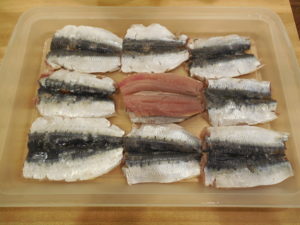

Place a little bit of the stuffing into each sardine, then close and place into a shallow cooking pan coated with a bit of olive oil.

Tear the bay leaves into several pieces and sprinkle them over the sardines .
Bake in the oven at 375°until sardines are cooked through and filling has browned, about 30 minutes.
When the sardines have finished cooking, sprinkle with freshly squeezed lemon juice and serve hot. Present them in their pan with the juices or transfer to a separate plate.

— by Kathryn Occhipinti
Kathryn Occhipinti, MD, is the author of the
Conversational Italian for Travelers series of books and a teacher of Italian for travelers to Italy in the Peoria and Chicago area.
“Everything you need to know to enjoy your visit to Italy!”
Join my Conversational Italian! Facebook group and follow me on Twitter at StellaLucente@travelitalian1 and start to learn Italian today for FREE!
Conversational Italian! Facebook Group
Tweet @travelitalian1 for Stella Lucente Italian
YouTube videos to learn Italian are available from © Stella Lucente, LLC.
Learn Conversational Italian.
More information on and photographs of Italy can be found on Facebook Stella Lucente Italian and Pinterest Stella Lucente Italian.
Facebook Stella Lucente Italian
Pinterest Stella Lucente Italian
Visit learntravelitalian.com/download.html to purchase/download Conversational Italian for Travelers and find more interesting facts and helpful hints about getting around Italy! Learn how to buy train tickets online, how to make international and local telephone calls, and how to decipher Italian coffee names and restaurant menus, all while gaining the basic understanding of Italian that you will need to know to communicate easily and effectively while in Italy. —From the staff at Stella Lucente, LLC
Italian Chicken Broth: Make Egg Drop Soup or Make it with Pastina Stars
